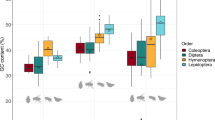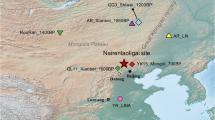Abstract
In this study we test the theory that the presence of the conserved vertebrate telomeric sequence (T2AG3) n at the centromeres of Australian marsupial 2n = 14 complements is evidence that these karyotypes are recently derived, which is contrary to the generally held view that the 2n = 14 karyotype is ancestral for Australasian and American marsupials. Here we compare the distribution of the (T2AG3) n sequence and constitutive heterochromatin in the presumed ancestral 2n = 14 complement and in complements with known rearrangements. We found that where there were moderate to large amounts of constitutive heterochromatin, the distribution of the (T2AG3) n sequence reflected its presence as a native component of satellite DNA rather than its involvement in past rearrangements. The presence of centromeric heterochromatin in all Australian 2n = 14 complements therefore suggests that centromeric sites of the (T2AG3) n sequence do not represent evidence for recent rearrangements.
Similar content being viewed by others
References
Abuín M, Martínez P, Sánchez L (1996) Localization of the repetitive telomeric sequence (TTAGGG)n in four salmonid species. Genome 39: 1035–1038.
Árnason Ú, Widegren B (1989) Composition and chromosomal localization of cetacean highly repetitive DNA with special reference to the blue whale, Balaenoptera musculus. Chromosoma 98: 323–329.
Blackburn EH, Gall JG (1978) A tandemly repeated sequence at the termini of the extrachromosomal ribosomal RNA genes in Tetrahymena. J Mol Biol 120: 33–53.
Carvalho BD, Mattevi MS (2000) (T2AG3)n telomeric sequence hybridization suggestive of centric fusion in karyotype marsupials evolution. Genetica 108: 205–210.
Close RL, Murray JD, Briscoe DA (1990) Electrophoretic and chromosome surveys of the taxa of short-nosed bandicoots within the genus Isoodon. In: Seebeck JH, Brown PR, Wallis RL, and Kemper CM, eds. Bandicoots and Bilbies. Sydney, Australia: Surrey Beatty &; Sons, pp 19–27.
Cooper DW, Edwards C, James E, Sharman GB, VandeBerg JL, Marshall Graves JA (1977) Studies on metatherian sex chromosomes VI. A third state of an X-linked gene: Partial activity for the paternally derived Pgk-A allele in cultured fibroblasts of Macropus giganteus and M. parryi. Aust J Biol Sci 30: 431–443.
De Leo AA, Guedelha N, Toder R et al. (1999) Comparative chromosome painting between marsupial orders: relationships with a 2n=14 ancestral marsupial karyotype. Chromosome Res 7: 509–517.
Eldridge MDB (1991) Chromosomal rearrangements and speciation in rock wallabies, Petrogale. PhD Thesis, Macquarie University, Sydney, Australia.
Eldridge MDB, Close RL (1993) Radiation of chromosome shuffles. Curr Opin Genet Dev 3: 915–922.
Eldridge MDB, Johnston PG, Close RL (1992a) Chromosomal rearrangements in rock wallabies, Petrogale (Marsupialia: Macropodidae). VI. Determination of the plesiomorphic karyotype: G-banding comparison of Thylogale with Petrogale persephone, P. xanthopus, and P. l. lateralis. Cytogenet Cell Genet 61: 29–33.
Eldridge MDB, Johnston PG, Lowry PS (1992b) Chromosomal rearrangements in rock wallabies, Petrogale (Marsupialia: Macropodidae). VII. G-banding analysis of Petrogale brachyotis and P. concinna: species with dramatically altered karyotypes. Cytogenet Cell Genet 61: 34–39.
Fagundes V, Yonenaga-Yassuda Y (1998) Evolutionary conservation of whole homeologous chromosome arms in the Akodont rodents Bolomys and Akodon (Muridae, Sigmodontinae): maintenance of interstitial telomeric segments (ITBs) in recent event of centric fusion. Chromosome Res 6: 643–648.
Garagna S, Broccoli D, Redi CA, Searle JB, Cooke HJ, Capanna E (1995) Robertsonian metacentrics of the house mouse lose telomeric sequences but retain some minor satellite DNA in the pericentromeric area. Chromosoma 103: 685–692.
Garagna S, Ronchetti E, Mascheretti S et al. (1997) Nontelomeric chromosome localization of (TTAGGG)n repeats in the genus Eulemur. Chromosome Res 5: 487–491.
Glas R, De Leo AA, Delbridge ML et al. (1999) Chromosome painting in marsupials: genome conservation in the kangaroo family. Chromosome Res 7: 167–176.
Griffith JD, Comeau L, Rosenfield S et al. (1999) Mammalian telomeres end in a large duplex loop. Cell 97: 503–514.
Harrison SR, Tamaschke HU (1984) Applied Statistical Analysis. Melbourne, Australia: Prentice-Hall of Australia.
Hayman DL (1977) Chromosome number-constancy and variation. In: Stonehouse B, Gilmore D, eds. The Biology of Marsupials. London, Great Britain: Macmillan Press, pp 27–48.
Hayman DL (1990) Marsupial cytogenetics. Aust J Zool 37: 331–349.
Hayman DL, Martin PG (1969) Cytogenetics of marsupials. In: Benirschke K, ed. Comparative Mammalian Cytogenetics. New York, USA: Springer-Verlag, pp 191–217.
Hayman DL, Rofe RH, Sharp PJ (1987) Chromosome evolution in marsupials. Chromosomes Today 9: 91–102.
Henderson E (1995) Telomere DNA structure. In: Blackburn EH, Greider CW, eds. Telomeres. New York, USA: Cold Spring Harbor Laboratory Press, pp 11–34.
John B, Lewis KR (1975) Chromosome Hierarchy. An Introduction to the Biology of the Chromosome. Oxford, Great Britain: Clarendon Press.
Kipling D (1995) The Telomere. Oxford, Great Britain: Oxford University Press.
Kipling D, Cooke HJ (1990) Hypervariable ultra-long telomeres in mice. Nature 347: 400–402.
Kirsch JAW, Lapointe F-J, Springer MS (1997) DNA-hybridization studies of marsupials and their implications for metatherian classification. Aust J Zool 45: 211–280.
Klobutcher LA, Swanton MT, Donini P, Prescott DM (1981) All gene-sized DNA molecules in four species of hypotrichs have the same terminal sequence and an unusual 3? terminus. Proc Natl Acad Sci USA 78: 3015–3019.
Lee C, Sasi R, Lin CC (1993) Interstitial localization of telomeric DNA sequences in the Indian muntjac chromosomes: further evidence for tandem chromosome fusions in the karyotypic evolution of the Asian muntjacs. Cytogenet Cell Genet 63: 156–159.
Liu WS, Fredga K (1999) Telomeric (TTAGGG)n sequences are associated with nucleolus organizer regions (NORs) in the wood lemming. Chromosome Res 7: 235–240.
Lowry PS, Eldridge MDB, Johnston PG (1995) Genetic analysis of a female macropodid hybrid (Macropus agilis x M. rufogriseus) and her backcross offspring. Aust Mammal 18: 79–82.
Metcalfe CJ, Eldridge MDB, McQuade LR, Johnston PG (1997) Mapping the distribution of the telomeric sequence (T2AG3)n in rock-wallabies, Petrogale (Marsupialia: Macropodidae), by fluorescence in situ hybridization. I. The penicillata complex. Cytogenet Cell Genet 78: 74–80.
Metcalfe CJ, Eldridge MDB, Toder R, Johnston PG (1998) Mapping the distribution of the telomeric sequence (T2AG3)n in the Macropodoidea (Marsupialia), by fluorescence in situ hybridization. I. The swamp wallaby, Wallabia bicolor. Chromosome Res 6: 603–610.
Metcalfe CJ, Eldridge MDB, Johnston PG (2002) Mapping the distribution of the telomeric sequence (T2AG3)n in rockwallabies, Petrogale (Marsupialia: Macropodidae), by fluorescence in situ hybridization. II. The lateralis complex. Cytogenet Genome Res 96: 169–175.
Meyne J, Ratliff RL, Moyzis RK (1989) Conservation of the human telomere sequence (TTAGGG)n among vertebrates. Proc Natl Acad Sci USA 86: 7049–7053.
Meyne J, Baker RJ, Hobart HH et al. (1990) Distribution of non-telomeric sites of the (TTAGGG)n telomeric sequence in vertebrate chromosomes. Chromosoma 99: 3–10.
Pagnozzi JM, Silva MJdJ, Yonenaga-Yassuda Y (2000) Intraspecific variation in the distribution of the interstitial telomeric (TTAGGG)n sequences in Micoureus demerarae (Marsupialia: Didelphidae). Chromosome Res 8: 585–591.
Pagnozzi JM, Ditchfield AD, Yonenaga-Yassuda Y (2002) Mapping the distribution of the interstitial telomeric (TTAGGG)n sequences in eight species of Brazilian marsupials (Didelphidae) by FISH and the correlation with constitutive heterochromatin. Do ITS represent evidence for fusion events in American marsupials? Cytogenet Genome Res 98: 278–284.
Pathak S, Dolhonde JA, Multani AS (1998) Amplification of telomeric DNA and the extent of karyotypic evolution. Cytobios 93: 141–146.
Qumsiyeh MB, Coate JL, Peppers JA, Kennedy PK, Kennedy ML (1997) Robertsonian chromosomal rearrangements in the short-tailed shrew, Blarina carolinensis, in western Tennessee. Cytogenet Cell Genet 76: 153–158.
Rens W, O'Brien PCM, Yang F, Graves JAM, Ferguson-Smith MA (1999) Karyotype relationships between four distantly related marsupials revealed by reciprocal chromosome painting. Chromosome Res 7: 461–474.
Rens W, O'Brien PC, Yang F et al. (2001) Karyotype relationships between distantly related marsupials from South America and Australia. Chromosome Res 9: 301–308.
Rofe RH (1978) G-banded chromosomes and the evolution of the Macropodidae. Aust Mammal 2: 53–63.
Rofe RH (1979) G-banding and chromosomal evolution in the Marsupials. PhD Thesis, University of Adelaide, Adelaide, Australia.
Rofe R, Hayman DL (1985) G-banding evidence for a conserved complement in the Marsupialia. Cytogenet Cell Genet 39: 40–50.
Salvadori S, Deiana AM, Elisabetta C, Floridia C, Rossi E, Zuffardi O (1995) Colocalization of (TTAGGG)n telomeric sequences and ribosomal genes in Atlantic eels. Chromosome Res 3: 54–58.
Schmid M, Feichtinger W, Nanda I et al. (1994) An extraordinarily low diploid chromosome number in the reptile Gonatodes taniae (Squamata, Gekkonidae). J Hered 85: 255–260.
Sharman GB (1961) The mitotic chromosomes of marsupials and their bearing on taxonomy and phylogeny. Aust J Zool 9: 38–60.
Silva MJdJ, Yonenaga-Yassuda Y (1998) Heterogeneity and meiotic behaviour of B and sex chromosomes, banding patterns and localization of (TTAGGG)n sequences by fluorescence in situ hybridization in the neotropical water rat Nectomys (Rodentia, Cricetidae). Chromosome Res 6: 455–462.
Southern EM (1970) Base sequence and evolution of guineapig ?-satellite DNA. Nature 227: 794–798.
Starling JA, Maule J, Hastie ND, Allshire RC (1990) Extensive telomere repeat arrays in mouse are hypervariable. Nucleic Acids Res 18: 6881–6888.
Sumner A (1972) A simple technique for demonstrating centromeric heterochromatin. Exp Cell Res 75: 304–306.
Svartman M, Vianna-Morgante AM (1998) Karyotype evolution of marsupials: from higher to lower diploid numbers. Cytogenet Cell Genet 82: 263–266.
Thomsen PD, Høyheim B, Christensen K (1996) Recent fusion events during evolution of pig chromosomes 3 and 6 identified by comparison with the babirusa karyotype. Cytogenet Cell Genet 73: 203–208.
Toder R, Wilcox SA, Smithwick M, Graves JAM (1996) The human/mouse imprinted genes Igf2, H19, Snrpn and Znf127 map to two conserved autosomal clusters in a marsupial. Chromosome Res 4: 295–300.
Vermeesch JR, De Meurichy W, Van Den Berghe H, Marynen P, Petit P (1996) Differences in the distribution and nature of the interstitial telomeric (TTAGGG)n sequences in the chromosomes of the Giraffidae, okapi (Okapia johnstoni), and giraffe (Giraffa camelopardalis): evidence for ancestral telomeres at the okapi polymorphic rob(4;26) fusion site. Cytogenet Cell Genet 72: 310–315.
Yen CH, Elliott RW (1997) Characterization of a Mus spretus YAC that maps to the pseudoautosomal region. Genomics 39: 19–29.
Young GJ, Marshall Graves JA, Barbieri I, Woolley PA, Cooper DW, Westerman M (1982) The chromosomes of dasyurids (Marsupialia). In: Archer M, ed. Carnivorous Marsupials. Sydney, Australia: Royal Zoological Society of New South Wales, pp 783–795.
Author information
Authors and Affiliations
Rights and permissions
About this article
Cite this article
Metcalfe, C.J., Eldridge, M.D.B. & Johnston, P.G. Mapping the Distribution of the Telomeric Sequence (T2AG3) n in the 2n = 14 Ancestral Marsupial Complement and in the Macropodines (Marsupialia: Macropodidae) by fluorescence in situ hybridization. Chromosome Res 12, 405–414 (2004). https://doi.org/10.1023/B:CHRO.0000034133.77878.88
Issue Date:
DOI: https://doi.org/10.1023/B:CHRO.0000034133.77878.88




